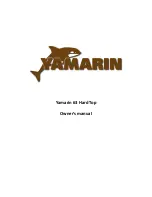
OWNER’S MANUAL
OPERATING IN HAZARDOUS CONDITIONS
64
5
3237 • X6 02/2018
Water Hazards
Every waterway poses hazards that you must be aware
of and avoid, including shallow water, tree stumps and
sand bars. Ask local authorities and other boaters for
information about known hazards, and consult a marine
chart when boating on unfamiliar waters. Try to avoid both
known and unknown hazards.
AQUATIC VEGETATION/WEEDS
Avoid operating in or near vegetation. Operating in
weeded areas can be extremely hazardous.
Vegetation and weeds in the water intakes can clog the
strainers, causing equipment to overheat.
NOTICE
DAMS AND SPILLWAYS
The waterways around dams and spillways are extremely
hazardous. Dams and spillways are subject to rapid water
flow changes, and there may be floating and sunken
debris in the nearby water. These areas are often marked
as restricted, and it is best to always stay clear of them.
SHALLOW WATER OPERATION
Operating in shallow water presents a number of
hazards. Sandbars in narrow inlets are constantly shifting,
making it difficult to mark them with buoys. Sandbars are
sometimes indicated by waves as they form into breakers
when passing over the sandbar. In coastal areas, tides
can affect water level as much as 30 ft (9 m). Check with
local marinas or Coast Guard stations for tide tables and
current charts.
Restricted Areas
Some waterways and areas are restricted. Always
check with local, state and federal authorities to identify
restricted areas. Because of the threat of terrorism, the
USCG enforces strict limits on watercraft near U.S. Navy
and Coast Guard ships and other potential targets. For
more information, contact the USCG or local authorities.
Markers
Become familiar with navigation markers, which identify
navigable routes and indicate water hazards. Always stay
within marked boundaries and steer clear of hazards.
KC-0015C-A
Figure 5-2
Always watch for swimmers and stay clear of all
swimming areas, marked or unmarked.
C34_Coupe.indb 64
2/8/2018 3:41:44 PM
















































